Abstract
To provide some insight into the current vitality of the experimental analysis of behavior, we updated and extended an analysis by R. A. Williams and Buskist (1983) of selected trends in the Journal of the Experimental Analysis of Behavior. Specifically, the number of articles published and the percentage of those articles that were empirical, the number of different affiliations of authors and number of articles per affiliation, the types of subjects used in empirical articles, and the topics investigated were analyzed for the years 1958 through 1999. Although several trends may point to a decline in the overall well-being of the experimental analysis of behavior, they may also be interpreted as signs of progress for the field.
Keywords: publication trends, JEAB, vitality, experimental analysis of behavior
Full text
PDF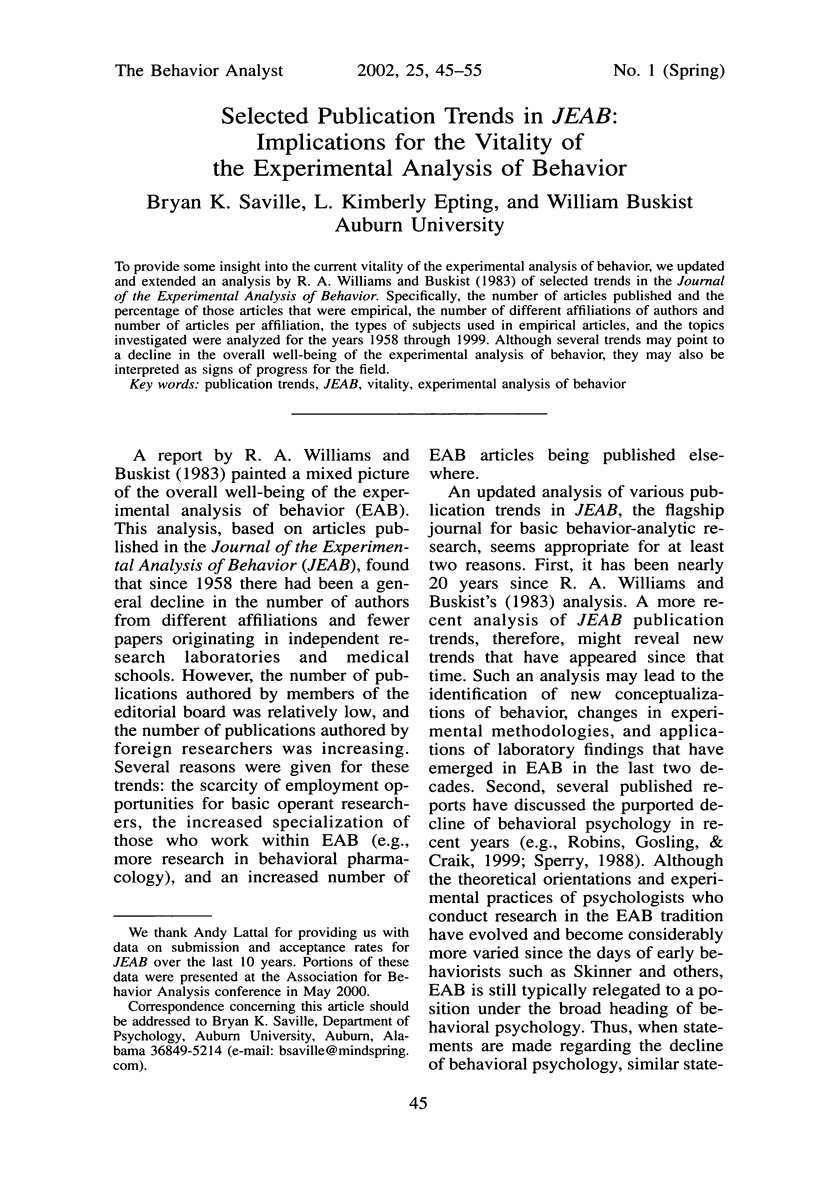
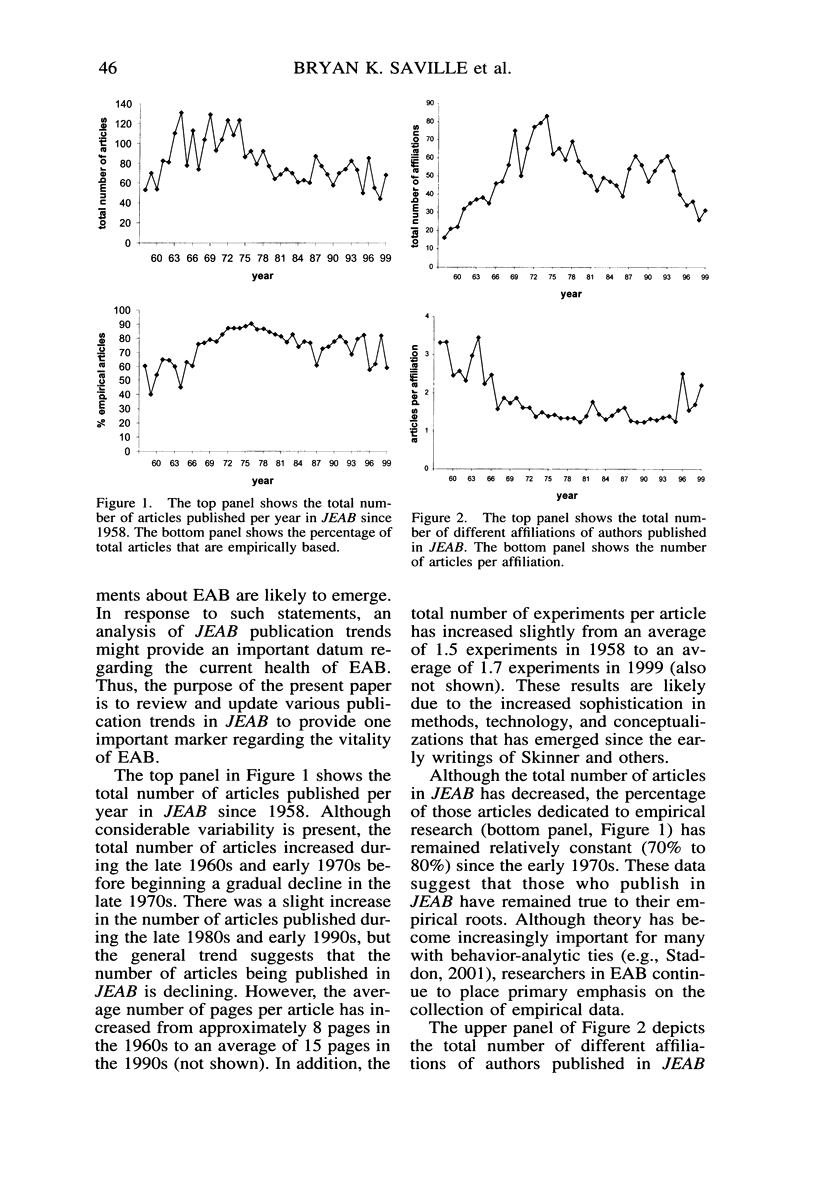
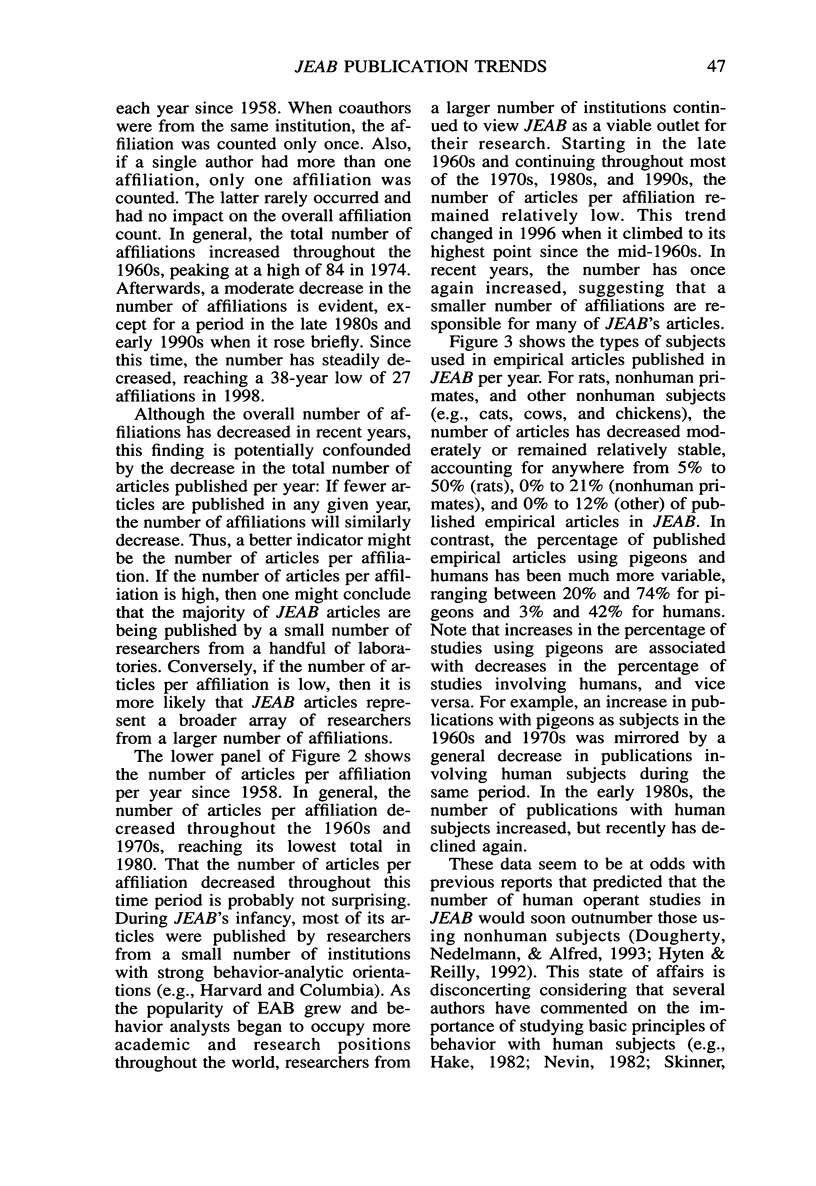
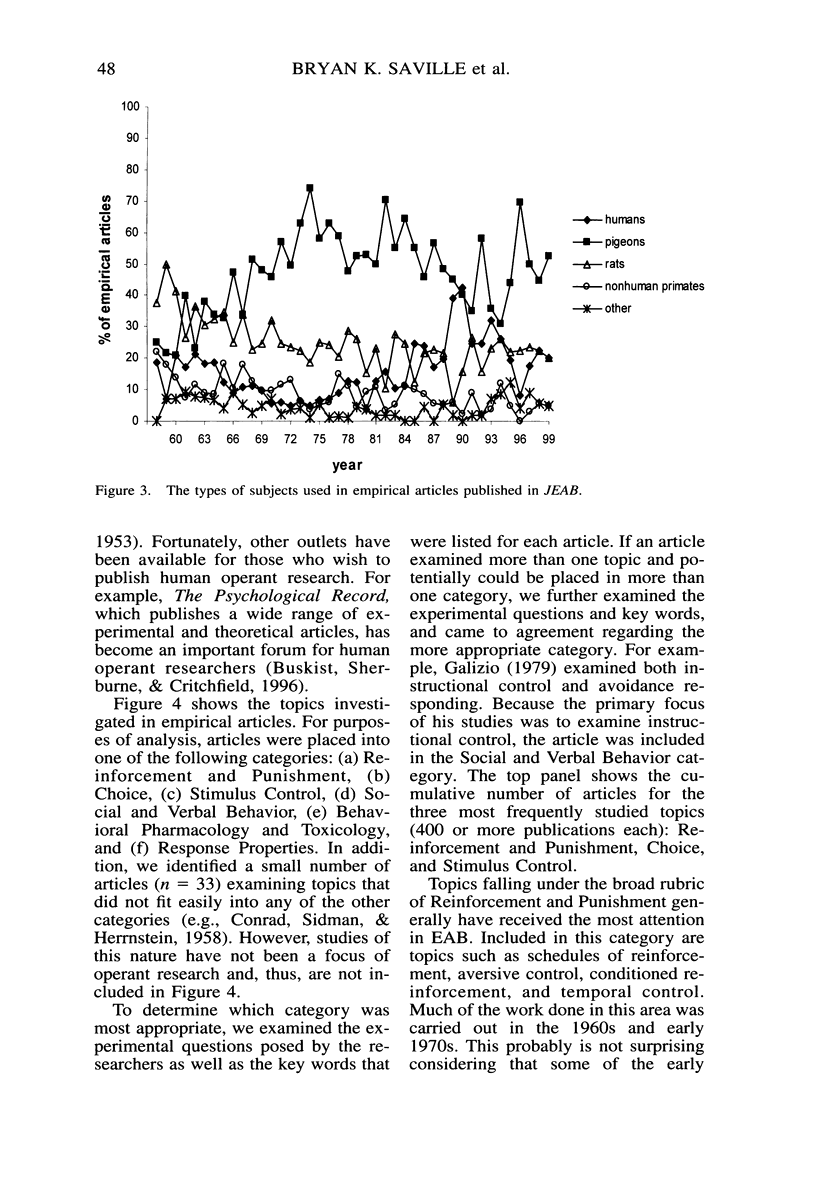
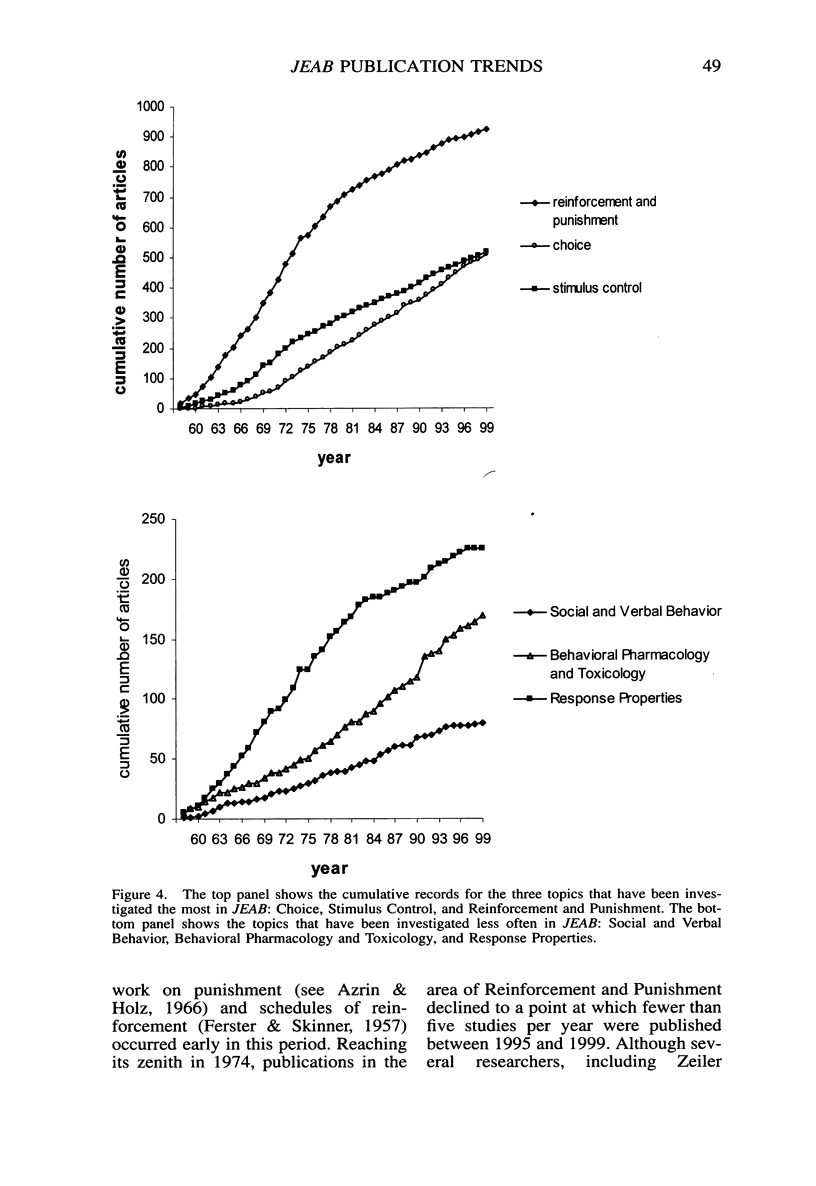
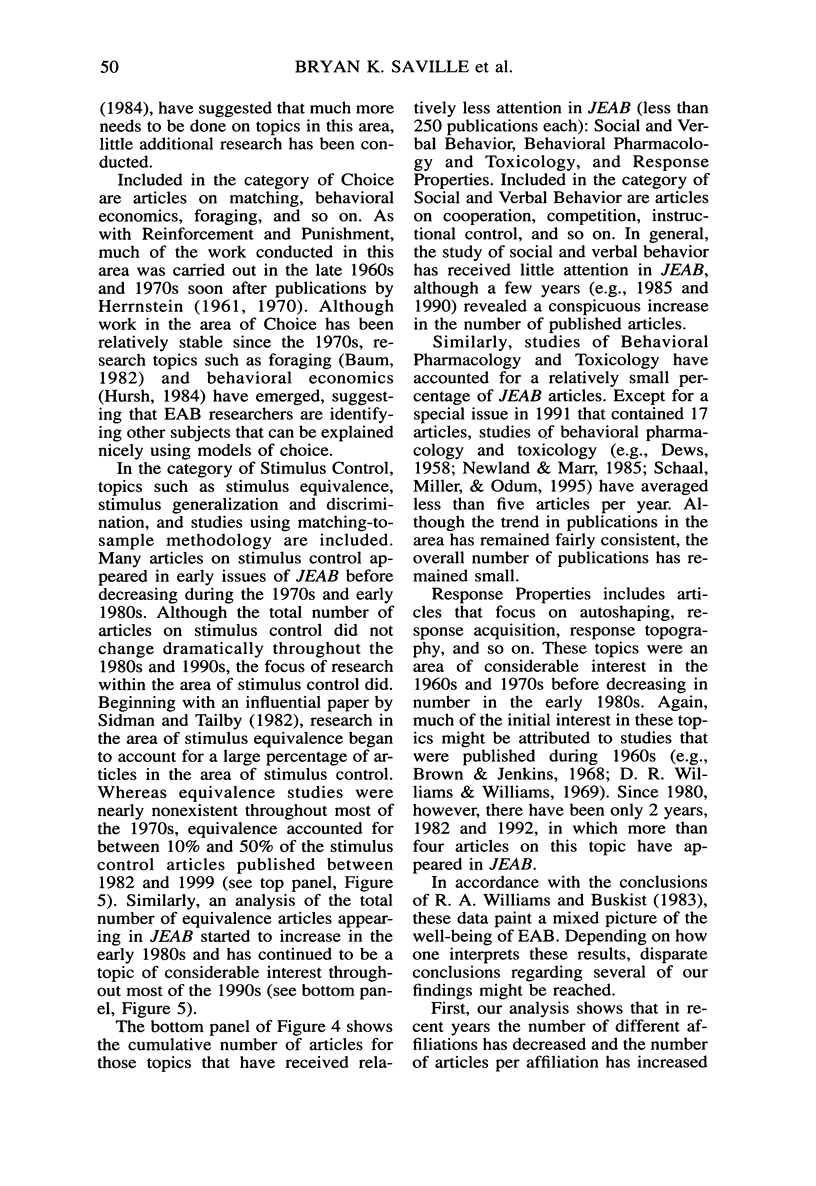

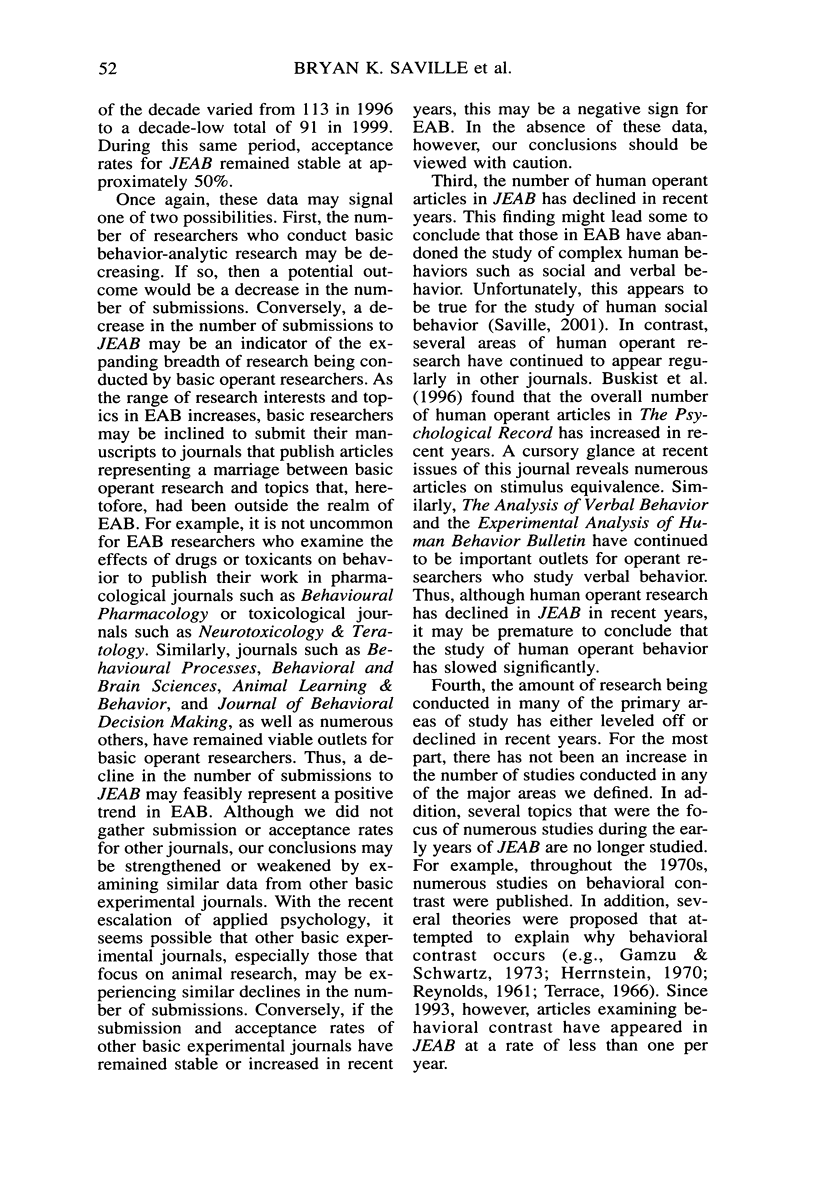
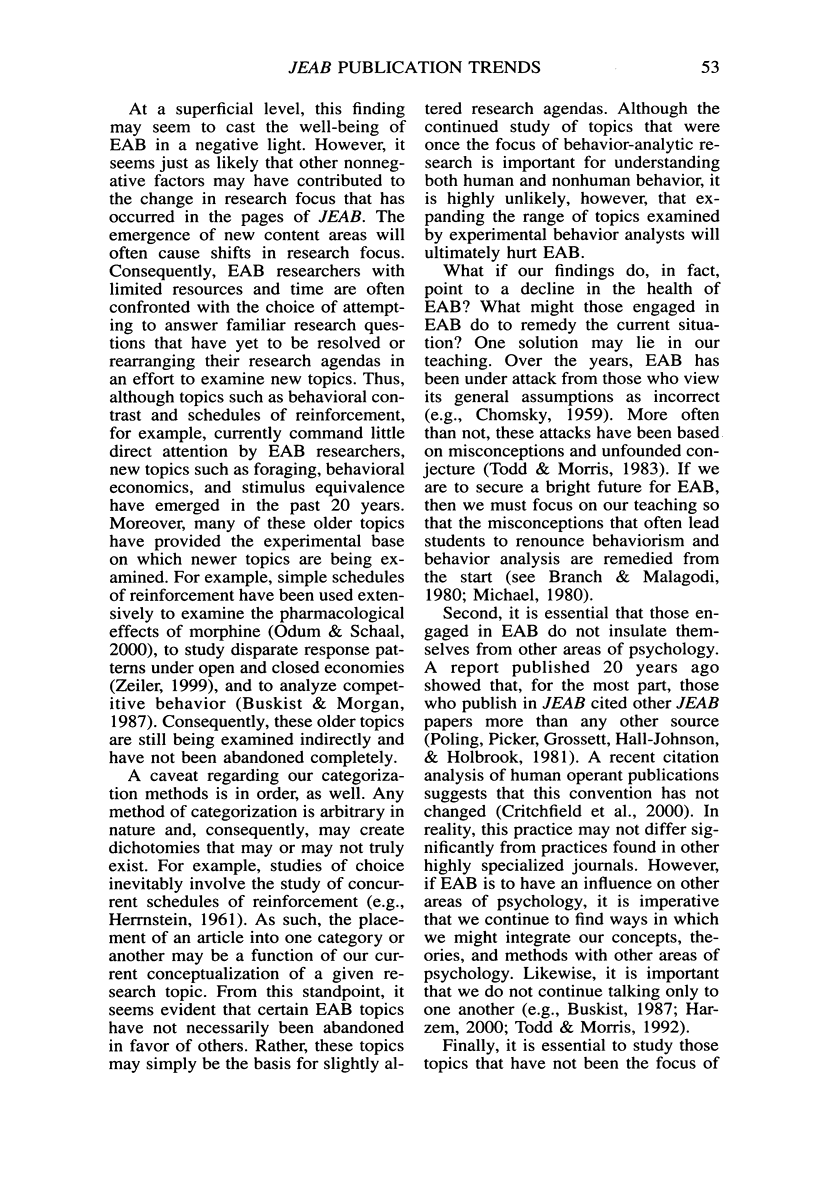
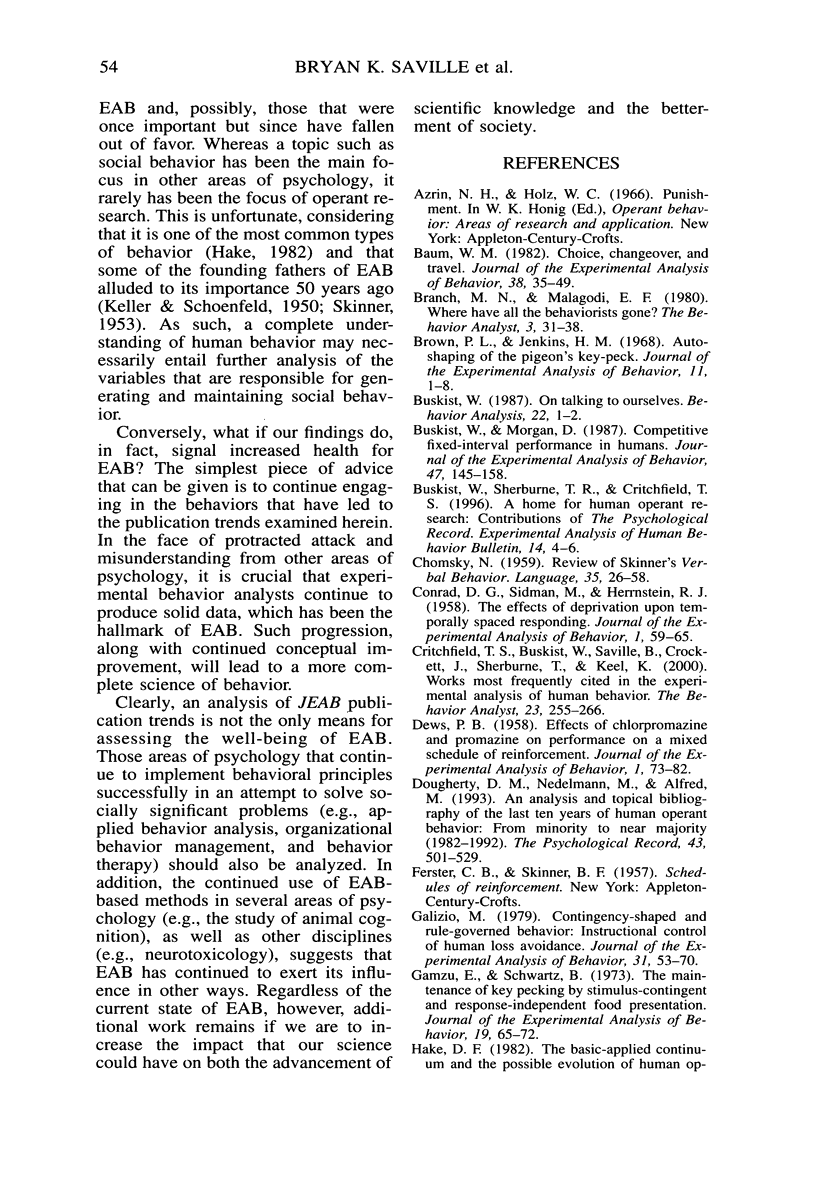
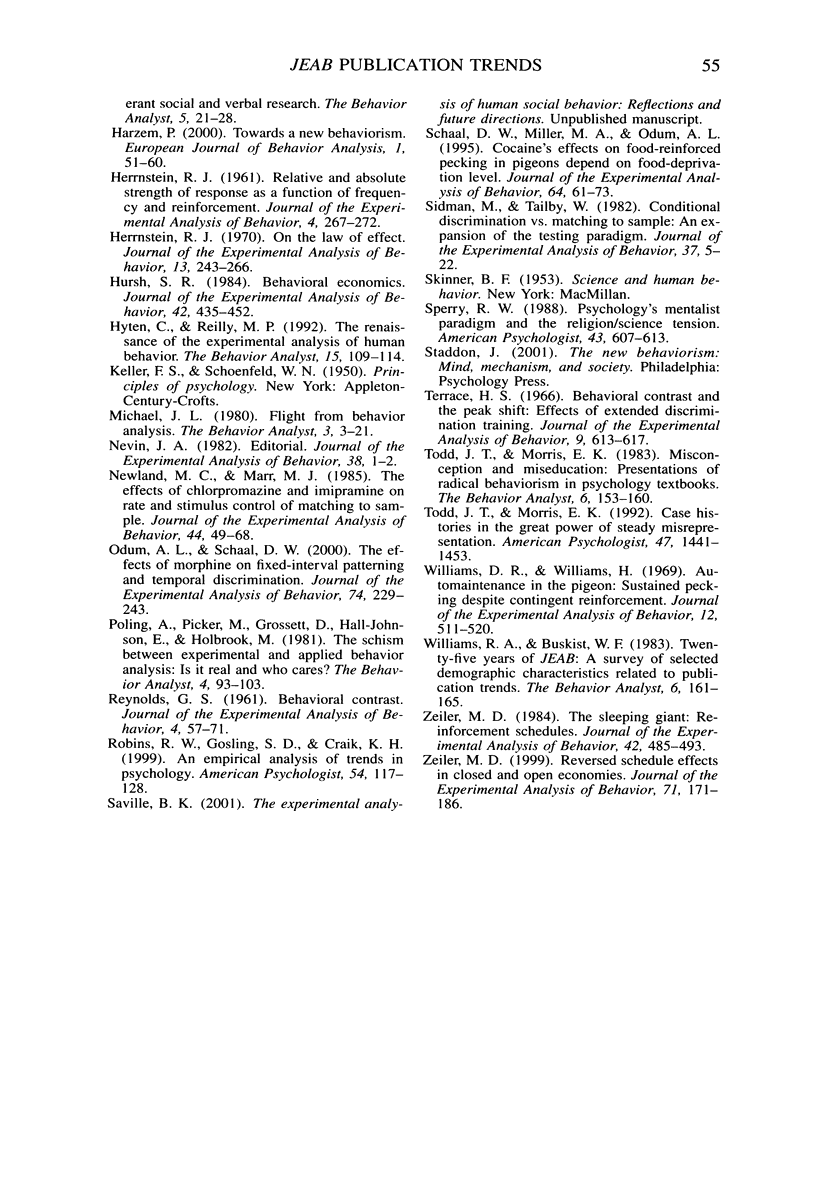
Selected References
These references are in PubMed. This may not be the complete list of references from this article.
- Baum W. M. Choice, changeover, and travel. J Exp Anal Behav. 1982 Jul;38(1):35–49. doi: 10.1901/jeab.1982.38-35. [DOI] [PMC free article] [PubMed] [Google Scholar]
- Branch M. N., Malagodi E. F. Where have all the behaviorists gone? Behav Anal. 1980 Spring;3(1):31–38. doi: 10.1007/BF03392376. [DOI] [PMC free article] [PubMed] [Google Scholar]
- Brown P. L., Jenkins H. M. Auto-shaping of the pigeon's key-peck. J Exp Anal Behav. 1968 Jan;11(1):1–8. doi: 10.1901/jeab.1968.11-1. [DOI] [PMC free article] [PubMed] [Google Scholar]
- Buskist W., Morgan D. Competitive fixed-interval performance in humans. J Exp Anal Behav. 1987 Mar;47(2):145–158. doi: 10.1901/jeab.1987.47-145. [DOI] [PMC free article] [PubMed] [Google Scholar]
- CONRAD D. G., SIDMAN M., HERRNSTEIN R. J. The effects of deprivation upon temporally spaced responding. J Exp Anal Behav. 1958 Jan;1:59–65. doi: 10.1901/jeab.1958.1-59. [DOI] [PMC free article] [PubMed] [Google Scholar]
- Critchfield T. S., Buskist W., Saville B., Crockett J., Sherburne T., Keel K. Sources cited most frequently in the experimental analysis of human behavior. Behav Anal. 2000 Fall;23(2):255–266. doi: 10.1007/BF03392014. [DOI] [PMC free article] [PubMed] [Google Scholar]
- DEWS P. B. Effects of chlorpromazine and promazine on performance on a mixed schedule of reinforcement. J Exp Anal Behav. 1958 Jan;1:73–82. doi: 10.1901/jeab.1958.1-73. [DOI] [PMC free article] [PubMed] [Google Scholar]
- Galizio M. Contingency-shaped and rule-governed behavior: instructional control of human loss avoidance. J Exp Anal Behav. 1979 Jan;31(1):53–70. doi: 10.1901/jeab.1979.31-53. [DOI] [PMC free article] [PubMed] [Google Scholar]
- Gamzu E., Schwartz B. The maintenance of key pecking by stimulus-contingent and response-independent food presentation. J Exp Anal Behav. 1973 Jan;19(1):65–72. doi: 10.1901/jeab.1973.19-65. [DOI] [PMC free article] [PubMed] [Google Scholar]
- HERRNSTEIN R. J. Relative and absolute strength of response as a function of frequency of reinforcement. J Exp Anal Behav. 1961 Jul;4:267–272. doi: 10.1901/jeab.1961.4-267. [DOI] [PMC free article] [PubMed] [Google Scholar]
- Hake D. F. The basic-applied continuum and the possible evolution of human operant social and verbal research. Behav Anal. 1982 Spring;5(1):21–28. doi: 10.1007/BF03393137. [DOI] [PMC free article] [PubMed] [Google Scholar]
- Herrnstein R. J. On the law of effect. J Exp Anal Behav. 1970 Mar;13(2):243–266. doi: 10.1901/jeab.1970.13-243. [DOI] [PMC free article] [PubMed] [Google Scholar]
- Hursh S. R. Behavioral economics. J Exp Anal Behav. 1984 Nov;42(3):435–452. doi: 10.1901/jeab.1984.42-435. [DOI] [PMC free article] [PubMed] [Google Scholar]
- Hyten C., Reilly M. P. The renaissance of the experimental analysis of human behavior. Behav Anal. 1992 Fall;15(2):109–114. doi: 10.1007/BF03392593. [DOI] [PMC free article] [PubMed] [Google Scholar]
- Michael J. Flight from behavior analysis. Behav Anal. 1980 Fall;3(2):1–21. doi: 10.1007/BF03391838. [DOI] [PMC free article] [PubMed] [Google Scholar]
- Newland M. C., Marr M. J. The effects of chlorpromazine and imipramine on rate and stimulus control of matching to sample. J Exp Anal Behav. 1985 Jul;44(1):49–68. doi: 10.1901/jeab.1985.44-49. [DOI] [PMC free article] [PubMed] [Google Scholar]
- Odum A. L., Schaal D. W. The effects of morphine on fixed-interval patterning and temporal discrimination. J Exp Anal Behav. 2000 Sep;74(2):229–243. doi: 10.1901/jeab.2000.74-229. [DOI] [PMC free article] [PubMed] [Google Scholar]
- Poling A., Picker M., Grossett D., Hall-Johnson E., Holbrook M. The schism between experimental and applied behavior analysis: Is it real and who cares? Behav Anal. 1981 Fall;4(2):93–102. doi: 10.1007/BF03391858. [DOI] [PMC free article] [PubMed] [Google Scholar]
- REYNOLDS G. S. Behavioral contrast. J Exp Anal Behav. 1961 Jan;4:57–71. doi: 10.1901/jeab.1961.4-57. [DOI] [PMC free article] [PubMed] [Google Scholar]
- Reid A. K., Staddon J. E. Schedule-induced drinking: Elicitation, anticipation, or behavioral interaction? J Exp Anal Behav. 1982 Jul;38(1):1–18. doi: 10.1901/jeab.1982.38-1. [DOI] [PMC free article] [PubMed] [Google Scholar]
- Robins R. W., Gosling S. D., Craik K. H. An empirical analysis of trends in psychology. Am Psychol. 1999 Feb;54(2):117–128. doi: 10.1037//0003-066x.54.2.117. [DOI] [PubMed] [Google Scholar]
- Schaal D. W., Miller M. A., Odum A. L. Cocaine's effects on food-reinforced pecking in pigeons depend on food-deprivation level. J Exp Anal Behav. 1995 Jul;64(1):61–73. doi: 10.1901/jeab.1995.64-61. [DOI] [PMC free article] [PubMed] [Google Scholar]
- Sidman M., Tailby W. Conditional discrimination vs. matching to sample: an expansion of the testing paradigm. J Exp Anal Behav. 1982 Jan;37(1):5–22. doi: 10.1901/jeab.1982.37-5. [DOI] [PMC free article] [PubMed] [Google Scholar]
- Terrace H. S. Behavioral contrast and the peak shift: effects of extended discrimination training. J Exp Anal Behav. 1966 Nov;9(6):613–617. doi: 10.1901/jeab.1966.9-613. [DOI] [PMC free article] [PubMed] [Google Scholar]
- Todd J. T., Morris E. K. Case histories in the great power of steady misrepresentation. Am Psychol. 1992 Nov;47(11):1441–1453. doi: 10.1037//0003-066x.47.11.1441. [DOI] [PubMed] [Google Scholar]
- Todd J. T., Morris E. K. Misconception and miseducation: Presentations of radical behaviorism in psychology textbooks. Behav Anal. 1983 Fall;6(2):153–160. doi: 10.1007/BF03392394. [DOI] [PMC free article] [PubMed] [Google Scholar]
- Williams D. R., Williams H. Auto-maintenance in the pigeon: sustained pecking despite contingent non-reinforcement. J Exp Anal Behav. 1969 Jul;12(4):511–520. doi: 10.1901/jeab.1969.12-511. [DOI] [PMC free article] [PubMed] [Google Scholar]
- Williams R. A., Buskist W. F. Twenty-five years of JEAB: A survey of selected demographic characteristics related to publication trends. Behav Anal. 1983 Fall;6(2):161–165. doi: 10.1007/BF03392395. [DOI] [PMC free article] [PubMed] [Google Scholar]
- Zeiler M. D. The sleeping giant: Reinforcement schedules. J Exp Anal Behav. 1984 Nov;42(3):485–493. doi: 10.1901/jeab.1984.42-485. [DOI] [PMC free article] [PubMed] [Google Scholar]
- Zeiler M. Reversed effects in closed and open economies. J Exp Anal Behav. 1999 Mar;71(2):171–186. doi: 10.1901/jeab.1999.71-171. [DOI] [PMC free article] [PubMed] [Google Scholar]


